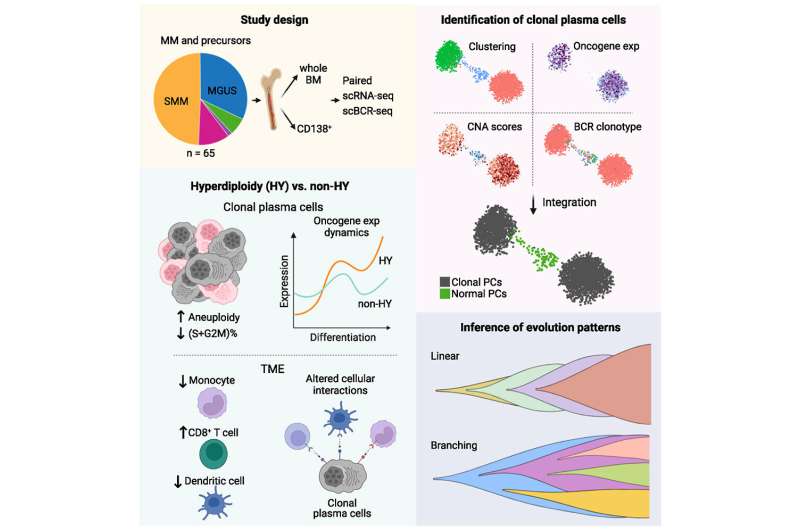This article has been reviewed according to Science X's editorial process and policies. Editors have highlighted the following attributes while ensuring the content's credibility:
fact-checked
peer-reviewed publication
trusted source
proofread
Study brings new understanding of multiple myeloma evolution

A new study by researchers at The University of Texas MD Anderson Cancer Center highlights novel insights into the evolution of multiple myeloma from precursor disease, which may help better identify patients likely to progress and develop new interventions.
Published in Cancer Cell, the study integrates paired single-cell RNA sequencing and B cell receptor sequencing from 64 patients with multiple myeloma or precursor disease. The study achieved several notable milestones in the effort to better understand this evolutionary process and is believed to be the largest cohort of myeloma precursor patient samples analyzed at single-cell resolution.
How multiple myeloma, a deadly and incurable cancer of plasma cells in the bone marrow, evolves from precursor conditions like monoclonal gammopathy of undetermined significance (MGUS) and smoldering multiple myeloma remains largely a mystery. To answer that question, this study was designed by Elisabet Manasanch, M.D., associate professor of Lymphoma/Myeloma, in collaboration with Linghua Wang, M.D., Ph.D., associate professor of Genomic Medicine, and Minghao Dang, Ph.D., postdoctoral fellow in the Wang lab.
"This research is a big step towards understanding the evolutionary roadmap that leads to myeloma," Wang said. "Additionally, there is a significant clinical unmet need to find and validate novel biomarkers to identify patients at high-risk of progression who would benefit the most from early treatment interventions."
New methodology allows for deeper understanding of evolutionary paths
Among the important achievements of this study is the methodology used for sample acquisition. While fluorescence in situ hybridization (FISH) currently is the standard of care for identifying genetic abnormalities in multiple myeloma precursors, low tumor purity in the precursor stage has been a known limitation.
By integrating FISH with single-cell sequencing data, the researchers were able to overcome this limitation and thoroughly analyze the transcriptomic landscape of even the earliest precursors. This also led to better refinement of genetic subtypes.
According to the researchers, integrating single-cell RNA sequencing and B cell receptor sequencing offers advantages for detecting clonal or aberrant plasma cells during the early stages of tumorigenesis.
For example, these plasma cells might already have undergone clonal expansion but remain less transformed, exhibiting genomic and transcriptomic characteristics similar to normal cells. This can result in misclassification when solely relying on the scRNA-seq approach.
Data reveal potential therapeutic targets, markers of risk for myeloma progression
One important finding was the substantial genomic and transcriptional heterogeneity present in the earliest precursor stages, including MGUS, even within a single patient. While previous studies have reported such heterogeneity, this study further uncovers that intratumoral heterogeneity extends to established myeloma-related genes, such as CCND1, CD38, BCMA, LAMP5, MYC, some of which have been targeted in clinical trials.
Additionally, the researchers conducted an in-depth characterization of changes at various levels (transcriptome, genome, and clonality) in relation to cell differentiation status and identified distinct correlation patterns within genetic subtypes. The dynamic changes in gene expression associated with myeloma throughout the differentiation process pointed to genes potentially related to disease progression.
"This study unravels the complexity of precursor plasma cells and their interactions within their environmental milieu at a much higher resolution than previously established thanks to the technological constraints that single-cell sequencing has now overcome," Manasanch said.
The study also revealed that precursor states predominantly followed a linear evolution pattern, while advanced multiple myeloma displayed a branching pattern, which may help researchers better understand the biological changes associated with disease progression.
Lastly, the researchers identified 15 major subtypes of immune cells and stromal cells within the tumor microenvironment. They observed noteworthy variations in the microenvironment composition as well as differences in the interaction between the tumor and microenvironment across samples of different genetic subtypes.
The ongoing study includes more than 250 patients, of which 64 were sequenced for this publication. The researchers continue to profile available samples and plan to further explore the potential for their discoveries to be translated into clinical impact.
More information: Linghua Wang, Single cell clonotypic and transcriptional evolution of multiple myeloma precursor disease, Cancer Cell (2023). DOI: 10.1016/j.ccell.2023.05.007. www.cell.com/cancer-cell/fullt … 1535-6108(23)00174-5


















